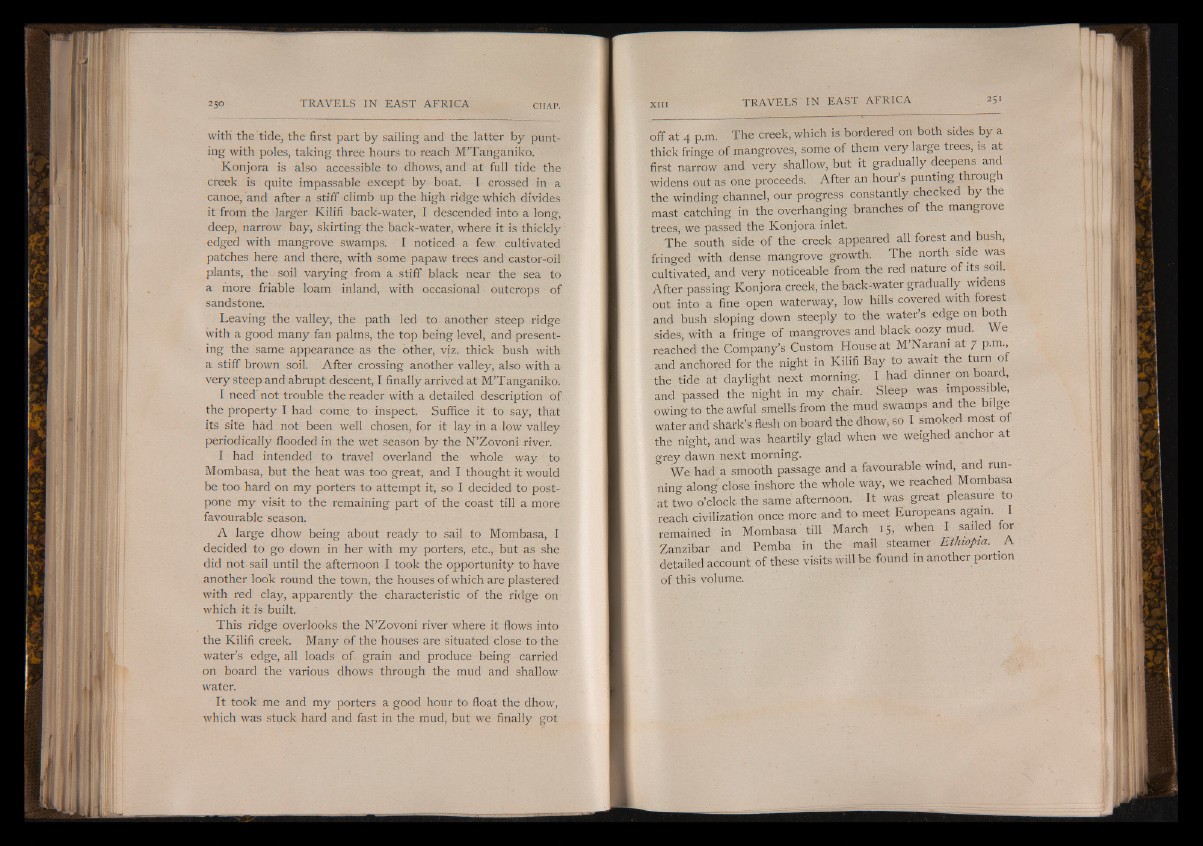
with the tide, the first part by sailing and the latter by punting
with poles, taking three hours to reach M’Tanganiko.
Konjora is also accessible to dhows, and at full tide the
creek is quite impassable except by boat. I crossed in a
canoe, and after a stiff climb up the high ridge which divides
it from the larger Kilifi back-water, I descended into a long,
deep, narrow bay, skirting the back-water, where it is thickly
edged with mangrove swamps. I noticed a few cultivated
patches here and there, with some papaw trees and castor-oil
plants, the soil varying from a stiff black near the sea to
a more friable loam inland, with occasional outcrops of
sandstone.
Leaving the valley, the path led to another steep ridge
with a good many fan palms, the top being level, and presenting
the same appearance as the other, viz. thick bush with
a stiff brown soil. After crossing another valley, also with a
very steep and abrupt descent, I finally arrived at M’Tanganiko.
I need’ not trouble the reader with a detailed description of
the property I had come to inspect. Suffice it to say, that
its site had not been well chosen, for it lay in a low valley
periodically flooded in the wet season by the N’Zovoni river.
I had intended to travel overland the whole way to
Mombasa, but the heat was too great, and I thought it would
be too hard on my porters to attempt it, so I decided to postpone
my visit to the remaining part o f the coast till a more
favourable season.
A large dhow being about ready to sail to Mombasa, I
decided to go down in her with my porters, etc., but as she
did not sail until the afternoon I took the opportunity to have
another look round the town, the houses of which are plastered
with red clay, apparently the characteristic of the ridge on
which it is built.
This ridge overlooks the N’Zovoni river where it flows into
the Kilifi creek. Many of the houses are situated close to the
water’s edge, all loads of grain and produce being carried
on board the various dhows through the mud and shallow
water.
It took me and my porters a good hour to float the dhow,
which was stuck hard and fast in the mud, but we finally got
off at 4 p.m. The creek, which is bordered on both sides by a
thick fringe of mangroves, some of them very large trees, is at
first narrow and very shallow, but it gradually deepens and
widens out as one proceeds. After an hour’s punting through
the winding channel, our progress constantly checked by the
mast catching in the overhanging branches of the mangrove
trees, we passed the Konjora inlet.
The south side of the creek appeared all forest and bush,
fringed with dense mangrove growth. The north side was
cultivated, and very noticeable from the red nature of its soil.
After passing Konjora creek, the back-water gradually widens
out into a fine open waterway, low hills covered with forest
and bush sloping down steeply to the water’s edge on both
sides, with a fringe of mangroves and black oozy mud. We.
reached the Company’s Custom House at M’Narani at 7 p.m.,
and anchored for the night in Kilifi Bay to await the turn of
the tide at daylight next morning. I had dinner on board,
and passed the night in my chair. Sleep was impossible,
owing to the awful smells from the mud swamps and the bilge
water and shark’s flesh on board the dhow, so I smoked most of
the night, and was heartily glad when we weighed anchor a t
grey dawn next morning.
We had a smooth passage and a favourable wind, and running
along" close inshore the whole way, we reached Mombasa
at two o’clock, the same afternoon. It was great pleasure to
reach civilization once more and to meet Europeans again,
remained in Mombasa till March 15, when I sailed for
Zanzibar and Pemba in the mail steamer Ethiopia. A
detailed account of these visits will be found in another portion
of this volume.